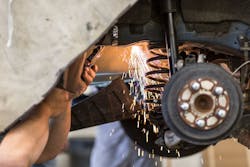As part of an ongoing study, I-CAR has surveyed welding instructors at over 100 of the company’s classes to pinpoint exactly what issues and hindrances are most contributing to improper welds.
Some of the results are surprising, and some are expected. But there is one commonality binding them all: Every common welding pitfall experienced by shops, Brian Wasson says, is completely, 100 percent solvable with a little effort and cooperation with your technicians.
Wasson, performance training coordinator for I-CAR, along with Richard Perry, OEM and strategic account sales manager for Chief Automotive Technologies, go over several welding mistakes they often encounter—and the simple solutions for each.
1. Perform Informal Vision Exams.
It’s a quote Wasson hears all too often: “If you can’t see, you can’t weld.”
And while that should go without saying, Wasson says it’s actually a common problem in the industry—in fact, as part of its previously mentioned ongoing study, I-CAR has found that technician vision for an aging workforce has so far been the most rampant issue.
“Having the ability to read the arc and follow a joint profile, while looking through a shaded lens, plays a crucial role in weld quality,” Wasson says. “It can be difficult, to near impossible, to produce quality welds if the technician can’t see the weld joint.”
Poor vision makes it difficult to weld in a straight line, follow a joint profile, and maintain consistent contact tip-to-part distance. If you’re worried about a technician’s vision, Wasson suggests performing an informal eye exam.
“The informal eye exam is done by having the technician read simple text, with their helmet up,” he says. “If all goes well, we then have them continue reading with their helmet down. If they have difficulty, we have a discussion with them about being able to see clearly what they are doing, while welding, and offer solutions.”
Solutions include updating prescription glasses, acquiring “magnified glasses” from the local pharmacy, or acquiring “welding helmet magnifiers,” which are simply a magnified lens that inserts inside the welding helmet to zoom in on the welding operation. Also, a clean protective lens on the face of the helmet helps, along with upgrading to a higher clarity helmet—all of these options are cheaper than redoing a job.
2. Prepare for Aluminum and Silicon Bronze.
Perry says being a gifted welder doesn’t necessarily make you ready for the the next phase of materials.
“A lot of guys are really good welders when it comes to steel welding, because I think in a lot of cases, it’s a little more forgiving,” he says. “But when you get into silicon bronze and aluminum, a lot of times you’re dealing with much thinner material, so it’s more important to have the proper setup.”
In addition to setting up the proper angles and speeds for aluminum and silicon bronze, Perry says a poor cleaning job prior to welding often causes issues.
“You’ve got to clean all sides of the material because if you’re welding and you’ve got oxidation on the backside, it’ll actually pull that into the weld,” he says. “If you’re overlapping two pieces, you’ve got to clean both sides, that way you’re not pulling any of that impurity into the weld.”
Also, be sure to adjust gas settings for aluminum and silicon bronze jobs.
“You need to be adjusting for pre- and post-gas,” Perry says. “When you hit the trigger, gas is going to come out before the wire moves, so make sure that gas is surrounding your weld. And then at the end, when you’re done welding and you let go of the trigger, there’s a post-gas that allows the gun to release the gas without any more wire coming out, and that’s just to help keep the weld clean. So make sure you’ve got the right flow meter, the right rate, the right gas.”
3. Update Welding Equipment.
I-CAR’s welding courses have certain requirements for every shop before it is deemed “fit” to host a welding class, and one of the most common issues is lack of proper equipment.
The company’s requirements, Wasson says, include a 200-amp-or-greater, pulse-capable, synergic welder for aluminum welding (oftentimes, shops requesting aluminum certifications only have a short circuit welder), and 140 amps or greater welder for steel welding.
“What we typically encounter is an underpowered, 100-amps-or-less welder that does not have the power requirement to produce quality welds per the I-CAR welding program, especially the plug welds,” he says.
“The converted short circuit welder to weld aluminum is not intended to weld thin sheet aluminum, while the pulse welders excel with thin sheet aluminum. Also, the 100-amp steel welder may do well with thin steel panels, but they are underpowered to produce passing welds.”
Essentially, your welding equipment needs to keep up with industry trends. Take the time to evaluate your shop’s equipment and make any necessary updates.
4. Double-Check Welder Settings.
Perry says it’s a common scenario: You power a programmable welder off, leave for a bit, and then come back, only to find the settings have changed.
Only, if you’re not being attentive, you won’t find anything.
“If someone else uses it, they might not realize you had it set a certain way,” he says. “They just came over and had to tack something up really quick and changed a couple settings and then they left. Then the next guy comes over, doesn’t think anybody used it, turns it on and goes right to welding, and it’s in a different program. So make sure the programs are set properly each time.”
5. Consider Your Building Infrastructure.
A quick explanation on voltage and amperage is essential to understanding this growing problem, Wasson says.
“Electricity is measured in two main categories: One is voltage and it is the measure of electrical pressure; the second measure is amperage, which is electrical flow,” he says. “The issue is that shops typically utilize a 110-volt circuit that also has radios, lights, computers, and other common electrical items, pulling from the same circuit that the 110-volt welder operates on. With all these other items pulling power from the circuit, it doesn’t allow the welder to operate at peak performance.”
In addition, there is a good chance that facilities pushing out many vehicles per day are utilizing multiple 110-volt welders at the same time, pulling even more power from the circuit, making matters worse.
"You can do a weld and think it looks great, but a trainer or another experienced welder should be able to look at a weld and tell you different things about the weld itself."
—Richard Perry, OEM and Strategic Account Sales Manager, Chief Automotive Technologies
“The on-the-spot solution to this problem is to discover what is pulling power from the circuit and isolate the unit’s drawing power before welding operations begin,” Wasson says. “This is not the most ideal situation of a production facility and introduces a large margin of error into the welds being performed.
“The better solution is to step up to a 220-volt welder since a 220-volt circuit will have more pressure available when a higher demand for power is called for.”
6. Evaluate and Critique Welds.
A lot of times, Perry says, welding mistakes come down to the fact that technicians are in their own heads.
“You can do a weld and think it looks great, but a trainer, or another experienced welder should be able to look at a weld and tell you different things about the weld itself,” he says. “Perhaps the angle is undercut; maybe you’ve heated one side of the panel too much; you could have had too low of voltage; or maybe you moved too fast.”
Perry says attending training is a great way to hone one’s skills, and will allow technicians to get second opinions on welds.




